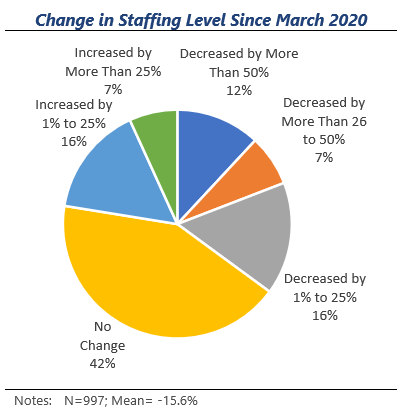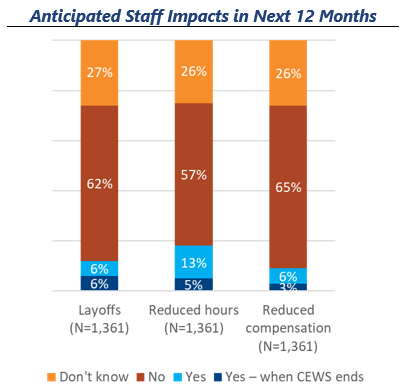This article is an excerpt from Human Resources Impact of COVID-19 on Canadian Charities and Nonprofits, a report published by CharityVillage and The Portage Group. The full report covers staffing, volunteering, and the use of government subsidies and relief programs and is based on a survey completed by 1,361 Canadian charities and nonprofits in February 2021. Click here to download the full report for free.
There is no doubt that COVID-19 has hit charity and nonprofit staff hard. A significant 33% of participating organizations laid off at least one staff member since March 2020. Nearly one-quarter (23%) of organizations engaged in permanent layoffs.
Moreover, participating organizations laid off an average of 2.1 staff in the past twelve months, one of which was permanent.

The combination of layoffs and natural attrition resulted in a cumulative 4.6% reduction in the total paid workforce across all participating organizations for a total loss of almost 3,200 jobs across 1,361 organizations. On a per organization basis, the average reduction was 16%. The difference between the cumulative sector total and the average per organization is because the cumulative total accounts for the size of organization staff complements.
Although the impact of COVID-19 on charity and nonprofit staff has been significant, it has not hit organizations equally across the sector. Just shy of one-quarter (23%) of participating organizations have actually increased their staff contingent since March 2020 while a further four in ten (42%) have not experienced changes to staffing levels.

Organizations who focus on children/family are the most likely to have seen a decline in the number of staff with 55% reporting fewer staff than in March 2020. However, the biggest impact has been on those focusing on arts/culture, where organizations saw an average reduction of 31% in their staff complement. Social service organizations fared the best with an average reduction of only 10% of their staff complement.
Organizations with less than $100,000 in revenue saw the largest average decrease in staff per organization at 30%, while those with revenues of $1 million to $5 million were the most likely to lose staff (41%).
Almost one-third of organizations (31%) reduced hours for at least some staff while 16% have reduced compensation for one or more staff.

Despite the challenges of the last year, the study results point to fewer layoffs of charity and nonprofit staff in the coming months. A majority of participating charities and nonprofits (62%) do not anticipate having to lay off more staff as a result of COVID-19.
The positive outlook is far from universal, however, as 12% of participating charities and nonprofits anticipate additional layoffs on the horizon. Half of these are dependent on when the Canada Emergency Wage Subsidy (CEWS) ends. For the 12% anticipating having to lay off more staff, half are anticipating having to lay off more than ten.
Reduced hours for some or all staff remains likely for 18% of participating organizations, with most resulting from the eventual cessation of CEWS. Just under ten percent anticipate further reductions in compensation for some of all staff.
The results also point to some uncertainty amongst participants, as just over one-quarter (26% to 27%) didn’t know if reductions in staff, hours, or compensation would be needed in the next 12 months.
This article is an excerpt from Human Resources Impact of COVID-19 on Canadian Charities and Nonprofits, a report published by CharityVillage and The Portage Group. The full report covers staffing, volunteering, and the use of government subsidies and relief programs and is based on a survey completed by 1,361 Canadian charities and nonprofits in February 2021. Click here to download the full report for free.











